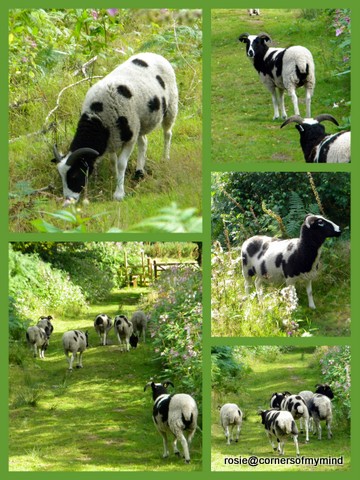Jacob Sheep on the Trentham Estate
It was lovely to see them as we walked up the hill towards the Monument. Apparently there are 31 sheep in this flock and they were obviously spread out across the moorland, grass and ferny areas of the walk. We saw a little group of no more than a dozen.
Here are some facts about Jacob Sheep
1. They are believed to be the oldest breed in the world and were first mentioned in the Old Testament Book of Genesis.
2. They were named after Jacob who worked for fourteen years for his father-in-law Laban without pay for the love of his wife Rachel. He asked to be allowed to keep his share of the sheep - all the speckled and spotted ones.
3. The sheep were taken to the Iberian Peninsula from North Africa in the 8th century.
4. Until recently the Jacobs were also called 'Spanish Sheep' as it was originally thought that the first sheep to come to Britain swam ashore from a sinking Spanish Galleon during the Armada of 1588.
5. During the 18th century they were also known as 'The Gentleman's Sheep' as they were used as decoration in the grounds of many stately homes and grand estates.
You can find out more from the Jacob Sheep Society

Aren't they lovely. My wedding going away outfit (many years ago!) was made from Jacob wool.
ReplyDeleteThey are, how wonderful to have worn something made from the Jacob wool:)
DeleteAre they the ones that they 'pluck' rather than shearing? Lovely animals.
ReplyDeleteI've been looking at the wesite and it does appear that they are sheared of their fleece:)
DeleteThe sheep are adorable, Rosie, but what I really like is the green green grass. Here it is brown and wilted and very hot.
ReplyDeleteAmalia
xo
Oh, I bet it was lovely to see the green grass, some of the leaves on the shrubs in our garden are turning a bit brown at the tips now after lack of rain:)
DeleteHow interesting, I don't think I've ever seen spotted sheep before.
ReplyDeleteThey are unusual aren't they?:)
DeleteSuch an interesting post - the sheep are so attractive no wonder they were used as decoration in country estates.
ReplyDeletere: comments in last post - cherries also expensive in farm shop :( I did spot some Greengage Jam there though but resisted temptation to buy. Interesting your comment about damson jam - the same thing happened to me when I made it years ago!!
I can quite see many owners of country estates having animals for their decorative appearane rather than any productive use they may have had.
Deletere the jam - I expect Damsons have a high pectin content, I always struggle with Strwberry jam as it is low in pectin, it ends up being more like a juicy sauce - nice on ice cream:)
They certainly have a great look about them, beautiful photos.
ReplyDeleteThank you they are lovely aren't they?:)
DeleteThey are truly beautiful. A blogger who lives south of the border, in the state of Washington, also has Jacob Sheep and makes beautiful, felted object from their wool.
ReplyDeleteI bet the things the owner of the Jacobs makes are wonderful:)
DeleteI LOVE these sheep facts! They are so coool, interesting AND historical!
ReplyDeleteGlad you enjoyed the sheep facts, Kezzie:)
DeleteWhat a lovely post! Delightful pics and fascinating facts. I do love a post about sheep. Thanks, Rosie. x
ReplyDeleteGlad you enjoyed the post Mts Tiggywinkle:)
DeleteAren't they just gorgeous with all those spots on! Fabulous! :-)
ReplyDeleteThey are an attractive breed of sheep aren't they?)
DeleteWe've just been to England and Scotland. One of my favourite scenes were the sheep in hilly, ferny, green, green fields.
ReplyDeleteThanks so much for sharing these Jacob photos and the info. Delightful tidbits of knowledge.
Wishing you a beautiful day.
Brenda
xox
Glad you enjoyed the post and I hope you had a wonderful visit over here:)
DeleteThey are so cute!
ReplyDeleteAren't they?:)
DeleteLove these sheep but may I suggest they are a flock (sheep),not a herd (cattle).
ReplyDeleteOf course they are! Thanks for pointing that out, I'll change it immediately:)
DeleteIt has always seemed rather unlikely that one would put to war with ships loaded with sheep! Whatever their origin I'm glad they arrived here, as they're fine looking little animals.
ReplyDeleteIt does seem odd to set off to war with animals dosen't it? I have heard of it before but usually cattle for milk and food:)
DeleteWho knew that sheep would have a society?!!! They have such unusual markings on their fleeces. I would have enjoyed seeing them too! x
ReplyDeleteThere are lots of clubs and societies for people who breed rare breed animals, it does make them seem rather special doesn't it?:)
DeleteI love sheep and herdwicks and Jacobs are my favourites! xxx
ReplyDeleteHerwicks are pretty aren't they, I'm also fond of rare breeds of sheep the Lincolnshire Longwool is another favourite:)
DeleteWhat beauties they are. Love the name gentlemen's sheep. You can just imagine them playing at being farmers in their palatial estates. An intriguing post with so much history. B x
ReplyDeleteThe image does fit in the the times of enclosure and Capability Brown doesn't it?:)
DeleteI have never heard of Jacob sheep. Fascinating post!
ReplyDeleteGlad you enjoyed it Mike:)
DeleteWhat a lovely scene, Rosie! Those Jacob sheep have lots of tasty, lush grass to graze on and they look well on it. They're also very decorative. Some interesting facts about them too. Thank you.
ReplyDeleteThey do look very healthy and well fed don't they? It was lovely to see them:)
Delete